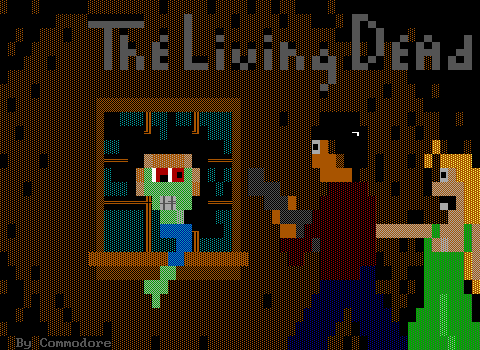A common trend of the past few years in the ZZT community has been the return of old faces. It seems that for every genuine newcomer, there are three ZZTers from days gone by showing up as well. It's been a pretty wild ride for a lot of us, and often those that return may seem like fresh faces, until you realize they name they go by now was not the one used fifteen plus years ago.
Having spent my teenage years on ZZT IRC channels, I am always excited to see familiar faces wandering back into the fray. It's been a nearly universal positive experience, even for those that may have been a little bit ...abrasive in the past (myself included). The trend is one of mellowing out over the years. Returning ZZTers are a welcome sight. This past September saw the return of dave2, a name that fellow ZZTers active on IRC in the 2000s likely remember warmly. (Or, if your brain has been ZZT-meme-poisoned, makes you think "dave2 is eight years old" [1].)
When older ZZTers return, it's up in the air if they're here to return to ZZTing and create once more, or to just enjoy the aesthetic and nostalgia, peeking at new releases and reminiscing when the screenshot bot posts the prison cell from Escape From Castle ZaZoomDa or some other burned in memory from their youth. Every time there is a release from a name with a lot of history behind it, it's always a cause for a small celebration. So when dave2 unexpectedly delivered a new release, all of us were glad to see his first ZZT release in almost twenty years.
But when I realized exactly what he released, I immediately pounced on the download button.
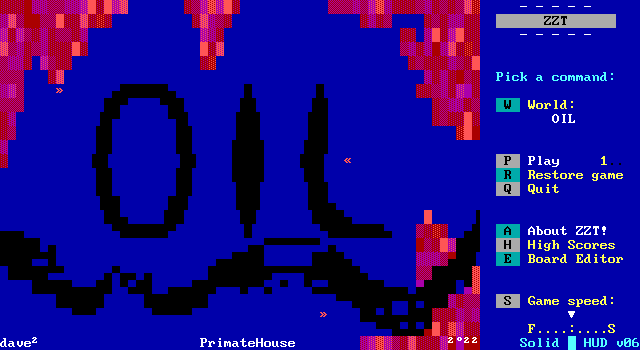
For most folks, dave2's Oil won't be immediately recognizable. It's not some ancient promised release finally being realized. This is not a title that elicits surprise to see like one might get from a full release of Flame Frost Blade, Sivion for MegaZeux, Frost 2, or The Mercenary 2 just to name a few. I suspect that without dave2 specifically explaining its origins in the file's description, that a lot of players of modern ZZT worlds would think it was a brand new creation with no history to it whatsoever.
Oil finally finishes a game that was never finished years ago, specifically Oil from the Autumn 2003 24 Hours of ZZT contest held by Flaming O. Now, to be clear, the incomplete game did not wow the judges back in 2003. The original game is a mere four playable boards long, with little for players to actually do until what would now be called a Flappy Bird engine caps the game off with an abrupt ending of a game clearly made with not nearly enough time to be realized.
Yet OG Oil didn't win the judge's favor because it was poorly made. No, this one is the judge's fault. The competition never had official results and so no scores were ever given! This was an unfortunately common occurrence with later 24HoZZT contests, as legit submissions dwindled and junk submissions rose. This contest was just one such victim that never got closure back in the day, and so Oil was cast aside.
Under normal circumstances, I too would have had no idea this was originally a 2003 24HoZZT game were if I hadn't actually played the original Oil (comparatively) recently. In fact, quite a number of people did! In 2018 I hosted an event to rally some volunteers to judge the unfinished contest. This is what made me decide I had to take a look at this game immediately[2]. Plus, it did a solid job in the modern scores despite being noticeably short and incomplete-feeling. A respectable third place out of eight submissions while being judged based on more modern standards and not the late teens hanging around in 2003. Looking at their feed back, it's apparent that the judges definitely wanted to see more of what dave was going for, myself included.
The modern Oil expands on the original significantly. While a few more complete 24 Hours of ZZT games had authors return to them after the contest to do a little polish before publishing them as their own stand-alone worlds, dave2 is practically starting from scratch. The main conflict, setting, and some character names are shared, along with some stylistically similar boards, but to classify this as an enhanced 24 Hours of ZZT game is a pretty misleading claim. It's it's own thing, and while those that do recall the original will appreciate finally seeing the concept done justice, that history is of no importance to new players.
What is important is dave2's creative approach to designing a ZZT world today. The original Oil is par for the course in 2003, lacking any opportunity to push things at all given its short length. The new Oil does a lot of things differently, not just if it had been released in 2003, but by modern standards. Oil winds up being a game that feels very different than most. Many of its gameplay mechanics are rarely, if at all, seen in other ZZT worlds. Although, as dave2 has been out of the loop for a bit, there are other ways in which the game does feel more like an older title. ZZT's modern renaissance has been going on long enough now that playing a game released in 2022 that doesn't do some of the extra more painful undertakings that are now much more expected. It wasn't until I played this release that I realized that we've gotten to the point where such special care has become the norm rather than the exception (or at least, that's the case for me). The sort of things that contemporary ZZT worlds do to ensure low-friction for players aren't seen here. It's nothing that can't be handled with liberal use of the save key, of course. Still, if you're somebody that first got into ZZT in the Museum era, while you'll still enjoy the trip, the ride may be a little bumpier than you're used to.
So let's take a look at the many ways dave2's Oil distinguishes itself from the rest, for better or for worse, in this long overdue undersea adventure!
Trouble Beneath The Waves
Oil takes place exclusively underwater in the area surrounding a small settlement of merfolk somewhere deep beneath the Pacific ocean. Life seems pretty peaceful for everybody, until the accident. Above the waves, something has happened to the Endemus, a toplander ship, and its crew causing it to drift aimlessly for days until it strikes a rock and begins to sink. Damage to the ship's hull causes its oil supply to begin spilling into the ocean, spoiling the previously clean waters that the aquatic residents rely on to breathe.
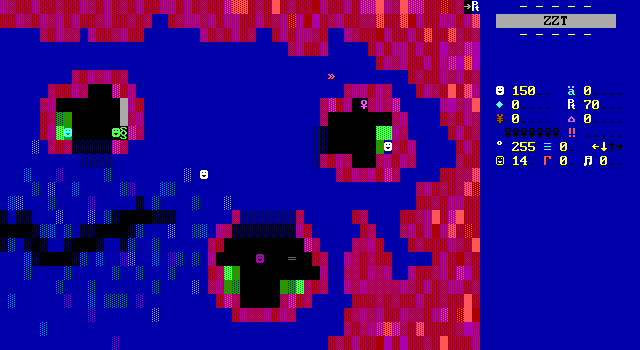
The village realizes none of this at first, only waking up to discover a foul black liquid choking the life out of everything it touches, and making it painful to breathe in smaller concentrations. The merfolk are unprepared for the sudden disaster. The colony's population skews old, too old for most to even try to play hero, and so it falls on young Peisinoë to investigate the source of the oil and find a way to stop the water from becoming further polluted.

As with the original incomplete release, this opening is shown through a great looking opening cut-scene, showing the Endemus on a moonlit night drifting and spilling its contents into the seas. This was a rather strong opening to begin with, and dave2 has returned to make it look even better. Using a board of almost pure black dave sets the scene quite well with hints of lapping dark blue waves and the distorted reflection of the moon shifting with the water it resides in. Instantly players can feel the severity of what's happened thanks to dave's presentation.
Meanwhile, the game's protagonist and player controlled character, Peisinoë wakes up gagging with the mysterious black liquid flowing right into the coral cave homes of her and her people. The situation is immediately dire with the village leader admitting that the older villagers would be unable to survive migrating to form a new settlement. Staying put is clearly not going to cut it either. Peisinoë, one of the only younger fish in the pond is tasked with identifying the source of the liquid, and finding a way to stop it before the waters are made completely inhospitable and the settlement perishes.
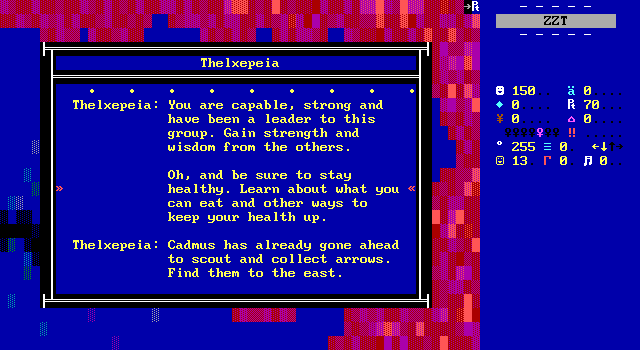
To do so, Peisinoë enlists the help of any who might aid her. While the villagers are able to help by keeping things running and not panicking, Peisinoë is pretty much on their own. While a few others have gone to investigate, Peisinoë is the most capable, and the others quickly bow out so that Peisinoë can do whatever it is they plan on doing.
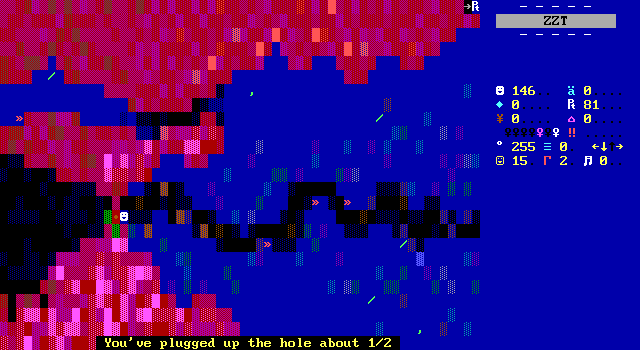
There's more to Oil than just following the trail. For one thing, currents are carrying the oil to her home from multiple locations. In some cases, Peisinoë can slow the spread, buying the settlement a little more critical time. However even they aren't permanent solutions. Peisinoë can also try to light the settlement's beacon, with other villagers holding out hope that it may summon them a hero.
However Peisinoë decides to approach the situation, it won't be long before the massive sunken Endemus is reached, with the nearby waters being littered with boxes of loose cargo. Using a breach in the hull, Peisinoë can board the ship, discover what happened to its crew, and try to find a way to somehow move the massive tanker away from their home. To accomplish this gargantuan goal, Peisinoë has to not only figure out the machinations of the Endemus's strange machines, but avoiding violent attacks from undead crew-members as well! These former humans are suffering from an illness brought about by their mysterious cargo, "redscale", a resource found underwater that drives toplanders mad, turning them into monsters who will stop at nothing to acquire more of it.
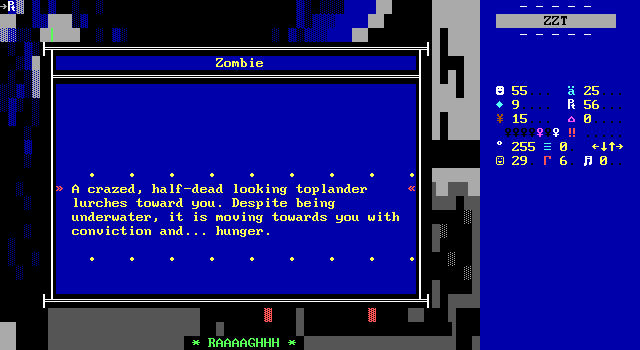
Peisinoë and the others are well aware of redscale and its effects on the toplanders. Fortunately they are immune to its effects themselves. The merfolk believe that redscale is proof that merfolk and toplanders can never live alongside one another. Unfortunately, despite hoping to keep away from those that live on the surface, Peisinoë won't be so lucky, as many of the crew hold keys that are required to access the ship's control room, in a hope to send it on a new course where its poisons will harm no one else. Still more must be obtained by exploring, both the Endemus plus the nearby waters where all sorts of toplander refuse have been turning the ocean into a real eyesore.
Mechanics
Where dave2 is at his best in Oil is undoubtedly the game's numerous systems that make it play unlike typical ZZT adventures, underwater or not. At the heart of nearly every choice of the game's design is the game timer. After the opening scene, players are instructed to choose a difficulty for the game. These choices determine starting health for Peisinoë as well as how much time is available to complete the game. The regular difficulty gives players seventy score to track how long until the water gets too polluted to survive. For experts, "Poseidon mode" reduces both the starting timer and player health to fifty. Lastly, and rather politely, "Peaceful mode" gives the player an extra fifty health, and removes the game timer entirely, allowing players to take the game at their own pace.
It's clear that the timer element is what the game is balanced around, and its existence is used to ensure every decision the player makes is one that needs consideration. Even the timer itself has a surprising amount of nuance to it. The timer ticks down at cycle ten, and only after a full line of twenty-one idles. Since this timer is handled by an object on every board, it means that it's very difficult to give an accurate assessment of just how much time players have. It's possible to leave a board just before the idles end and return later, losing a point immediately. This is more of a ZZT decision than a dave2 one of course.
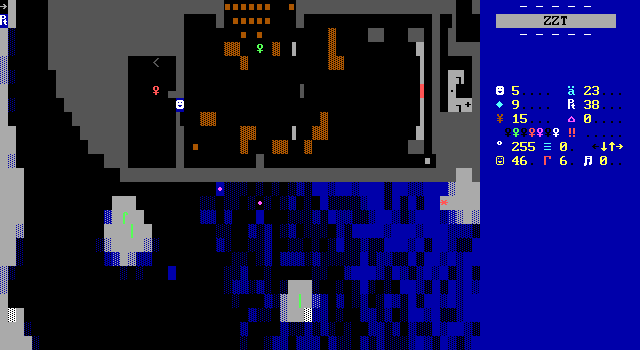
Where dave does get to take full responsibility is in the choice of how many idles and how many points players get. Most often, live counter-based timers like this one operate at cycle one and tick down constantly, running at ZZT's rate of roughly 9.1 ticks per second. Such timers make it very easy to estimate how much time remains in actual seconds, as well as making it clear how much time is being spent doing whatever you're up to at any given moment. The slow timer with long (sometimes erratic) intervals prevents players from doing this. I found myself always just a little anxious, never daring to stand still long enough to watch the timer go down. The same trick also makes it hard to estimate progress through the game. While the timer is omnipresent, players can't reliably use it to feel their progress through the game. I had no idea if I was going to finish the game by the skin of my teeth or with plenty of score to spare.
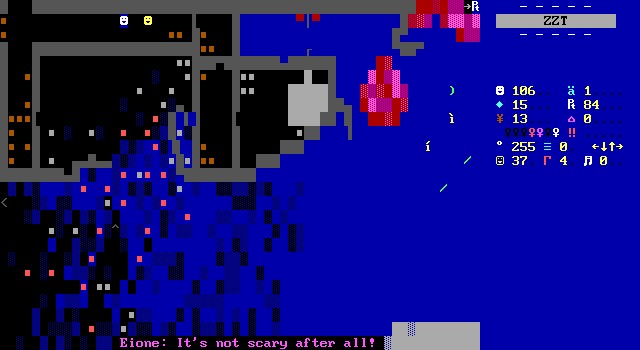
It gets even more complicated thanks to the game's quest system. All Peisinoë has to do is board the Endemus, restore a few busted bits of machinery, and play with the ship's controls. If she helps to complete other tasks, it's possible to gain score and by more time for the merfolk. Some of this makes obvious sense like plugging up smaller holes oil is spilling through with seaweed, but nearly anything that helps out around the village will provide some benefit to the time remaining. Finding a missing pet, providing materials for crafting arrows, and simply discovering a fellow villager that got trapped while exploring the Endemus themselves will all provide.
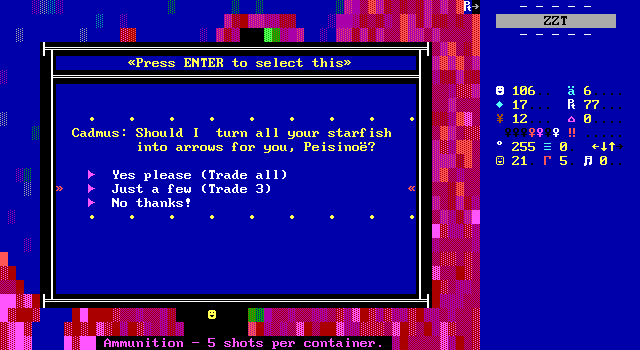
Though these quests rarely provide direct benefits to Peisinoë, even players in a hurry will find themselves considering helping out. Several quests will gets villagers to begin providing services to Peisinoë. Delivering starfish to Cadmus will allow players to exchange them mermish arrows or give them to Alcyone to make healing potions. Of course, these services require returning to the village to take them up on their offers. It's up to players to decide when it's worth swimming back to town. Perhaps Peisinoë can find a shortcut or two to made trips a little less costly time-wise?
As far as health goes, potions aren't the only ways to heal. The numerous trade-offs dave2 gives players for healing are genuinely one of the most well-designed forms of resource allocation I've ever seen in a ZZT game. You can exchange starfish for potion, but dave2 also provides players the chance to heal the same amount freely and infinitely[3], and right from the very first board of the game no less!
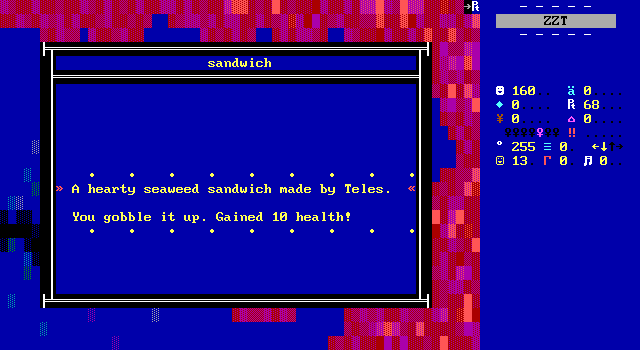
Teles, the village cook is the first to realize that standing by idly will be no help, so she does the only thing she can do. Cook. She makes seaweed sandwiches, giving Peisinoë the go-ahead to eat as many as they like. This is the case for the entire duration of the game, so if the player wants to eat twenty sandwiches they totally can. There's a catch of course, it takes time to make the sandwiches, with only one being available at a time. So while it is possible to fill both stomach and health, doing so burns the game's most limited resource: time.
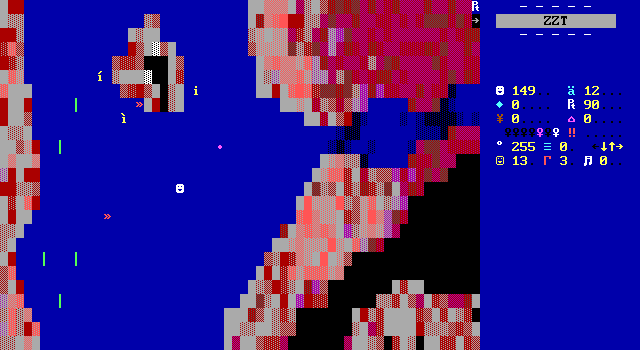
A similar mechanic is used for other health sources found naturally in the ocean's waters. Wild seaflowers can be found on many boards restoring three health when munched on. Raw seaweed, not properly prepared for sandwiches can be eaten in desperation, restoring just a single health point, with criticism of the taste as a side dish. Both these objects have their own local timers before they blossom once again making them perfect for a quick snack, but a lot tougher to justify waiting around for seconds. Strangely, the seaweed can actually be exhausted if harvested too many times. Given the lengthy delay and small amount of health restored, it's unlikely that players will run into this without trying. It's the sort of behavior I only noticed thanks to looking at game code.
There's one other interesting aspect of resource gathering, but perhaps it's best saved for the next section, as it comes not from plants, but from animals.
Aside from the time/resource management, dave2 has also tweaked ZZT's basic combat system. Peisinoë starts unarmed, but can acquire two forms of offense by completing certain questlines. The one that players will definitely manage to do is the aforementioned starfish to arrow exchange with Cadmus. Arrows are in countless ZZT worlds as a simple one-to-one replacement of bullets to fit in better with less technologically advanced settings. Here though, dave operates on undeniable logic: It's really hard to shoot arrows underwater!
Instead of bullets showing up and traveling until they hit something, dave2 implements what under most circumstances would be considered a sword engine. When a bullet is detected, an object idles for a bit, and then manually changes all bullets on screen to empty space. Few games have actually implemented this kind of combat system as it prevents enemies from using bullets as well, as it would allow their own shots to trigger the code to erase any bullets on screen. My own Ruins of ZZT release from 2016 is the only full game I'm aware of that went through with it, and I felt the lack of tigers.
Once more dave2 makes some small modifications that make the system more fun to play with. The object that checks for bullets runs at cycle two, meaning that your arrow's maximum range isn't fixed, fluctuating depending on what tick the shot was fired on. This makes longer ranged shots a little more dicey.
While health can be recovered in small amounts, Peisinoë's only option to get more arrows is to trek all the way back to the village, making every shot count even though running out isn't the death sentence it would be in typical ZZT action games. For another twist, dave doesn't limit the number of shots per board, allowing players to fire additional arrows as fast as they can. This is explained in game as shots falling short, with Peisinoë struggling to ready, aim, and fire in such a hurry. It's advised to voluntarily wait until missed shots are erased before shooting again, but the option is there in a moment of panic to quickly fire a second shot in a different direction and hope it's able to reach its target in time.
Peisinoë's second weapon is the obligatory trident. These are rare and valuable artifacts, with nobody in the village possessing one. Acquiring one is a bit of a pain, and if you're willing to you can skip it entirely. The trident allows Peisinoë to defeat some enemies by simply touching them, which is advantageous not just because for ammo conservation, but because arrows merely stun rather than kill. I personally got tired of not having a trident and looked up how to acquire one, discovering that the process is it's a little too un-hinted at for my tastes. Upon lighting the beacon to summon a hero, somebody will show up, but not at the village as I expected. Instead they'll swim in from outermost edge of the game's world. From here getting the trident is basically a given, but I didn't think the beacon's status would be relevant on that board, and so I saw no reason to return.
Marine Biology
So Peisinoë has their arrows and trident, but what does the player get to use them on?
Only four species can be found swimming around. Thankfully, several aren't even hostile. Even if they aren't trying to bite, even the nicer lads of the sea are still capable of causing trouble.
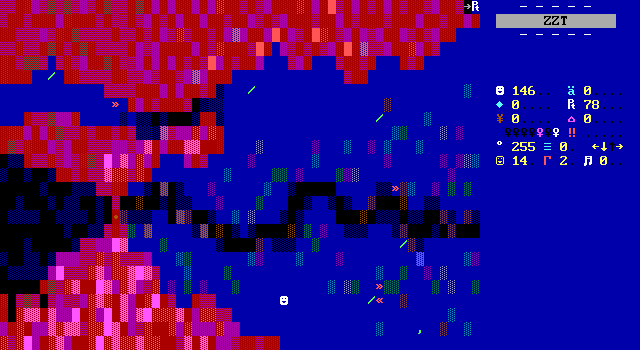
Targetfish - These red fish are found pretty much everywhere. The reason for the name is that they shrug off mermish arrows, so archers frequently use them for target practice. These fish also love freshly cut seaweed, which can be a problem when you're carrying some to try and plug up a hole currently spewing oil.
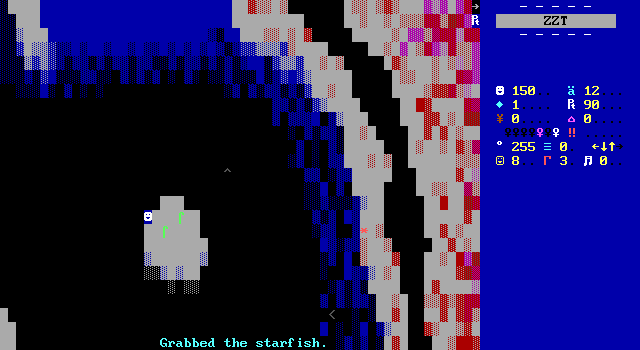
Sharks - Sorry shark lovers, these guys are bad news here. They hunt in packs, charging at the player when they catch a glimpse. Arrows only stun them, but are an effective shaming tool. Sharks hit with arrows will leave Peisinoë alone afterwards. However, as pack hunters, if a shark does manage to bite, the others on the board will regain their courage and resume actively hunting their clearly vulnerable prey. Prior to detecting players, they follow a mostly predictable back and forth pattern, giving players the chance to try and avoid them.
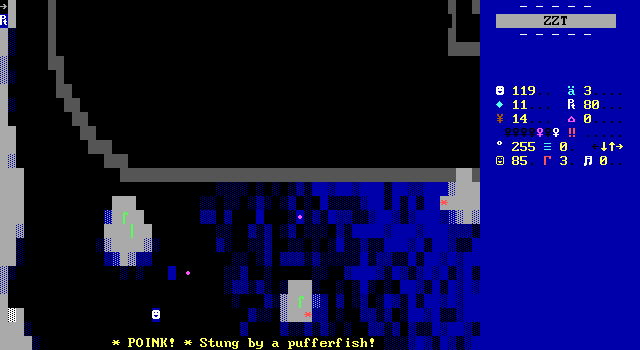
Pufferfish - Forget the sharks. These fish are incredibly annoying. Perhaps best described as a Lost Soul from Doom, wandering aimlessly until they see an opportunity to charge at the player. Unlike sharks, arrows have no effect at all, so without a trident the only option available is to keep away. This is easier said than done, as when not aiming for the player their movements are a lot more erratic.

Anglerfish - Another friend. These fish just want to vibe. They just so happen to be the source of scales, the last resource used by the game. By swimming up close to one, Peisinoë can wait for a scale (torch) to be shed, and collect it. These scales are prized by the merfolk for their oily coating that works as a fuel source and lubricant. Players wishing to light the beacon will have to harvest a number of them, taking care not to accidentally touch these skittish creatures, which causes them to run and flee for a short while.
Other than the rather clever scale harvesting seen with the anglerfish (yet another instance of the game's timer being a core component to the rest of the gameplay), the creatures here might not seem too impressive at face value. The ZZT enemy that charges when aligned is a long running staple of object based opponents. (See: Turmoil.) A common issue with action in ZZT is how many authors seemed to just haphazardly place whatever enemies they whether that be built-ins or custom enemies, with little thought to the environment they're being placed in. Dave does a great job of ensuring that enemies are exactly where players won't want them to be. Trying to harvest those anglerfish scales? Have fun constantly being poked by a pufferfish. Trying to navigate spilled cargo? Be mindful of sharks pushing debris all over the place.
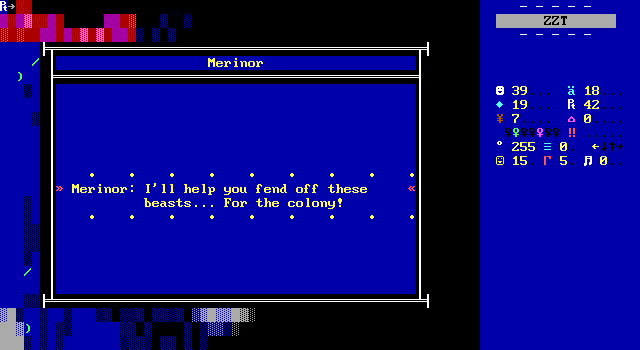
These enemies (and neutral ...ies), when combined with the limited range of arrows, do a great job of being threatening, but not inescapable. The boards which are more open sea would easily turn into lining up with foes and sniping from a distance if the player had the usual infinite range. Realizing that the best way to deal with a shark is to stare it down and shoot your shot at the last moment to compensate for any fluctuations in arrow range transforms the nature of the game's boards. Boards which most games would let players casually swim around with all the time in the world to react turn into gripping fights where it's you or them.
Of course, one's idea of what being bit by a shark is like probably doesn't line up with dave's interpretation. Sharks only deal five damage at a time, and pufferfish three. The former crew are the only enemies that operate at the usual value of ten damage per attack, and they too are only stunned by arrows.
Aboard The Endemus
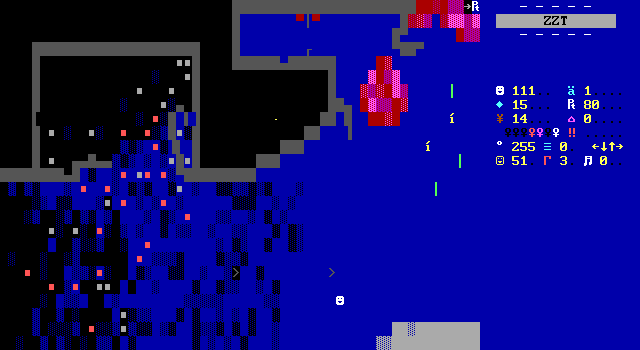
The first half or so of Oil is spent navigating the waters in search of the Endemus, the sunken ship responsible for the oil crisis. While the oceanic setting might conjure ideas that the world will be massive and the boards will be barren, dave2 has turned his ocean into a much more linear affair. Coral caverns are the usual obstruction which help guide the player along a mostly fixed path. Things aren't entirely linear, so players still have some opportunity to explore in different directions even if you're likely to make all your discoveries in the same order as anyone else.
Dave is committed to keeping the ocean feeling open even if by the nature of being a ZZT world, it has to be an enclosed space. To get around the issue of the ocean's need for borders, the game implies that Peisinoë is heading deeper into the depths as they explore. What begins as dark blue slowly fades to darkness, forming a natural boundary that stops merfolk from mapping the ocean floor for safety concerns rather than having to implement artificial barriers to force players to change direction. This is especially emphasized in the darkest part of the sea where the anglerfish can be found. There are multiple entrances to this board, which loops on three sides with one exit. (A bit like the Lost Woods of the original Legend of Zelda.)
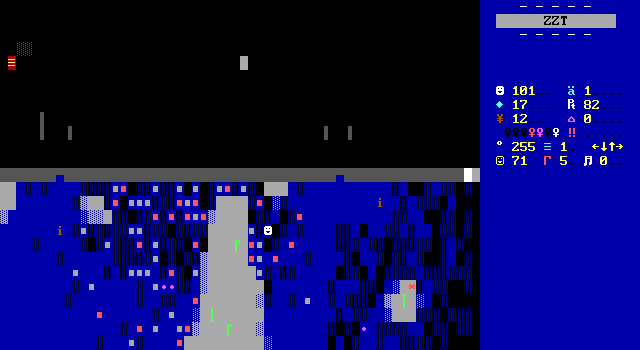
When the player has discovered the location of the Endemus, there's not a whole lot left to uncover. The next problem to be solved is how to actually get inside. Plenty of potential entrances are closed off due to doors being stuck with crates of cargo preventing the doors from being pushed open. Eventually an accessible opening can be uncovered, as long as you've got something on hand to grease the door.
Inside, the rules of the game shift quite a bit. The get a bit unclear in some ways. The sunken ship is surely filled with water for Peisinoë to swim around in, but at the same time it feels very dry inside, with one room even featuring a pressurized water cannon used to clean up a mess. It's probably best not to spend time thinking about the logistics of the interior, and focus instead on the sudden introduction of a number of puzzles that need solving.
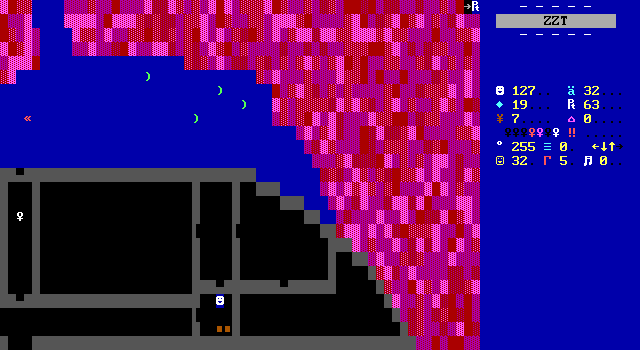
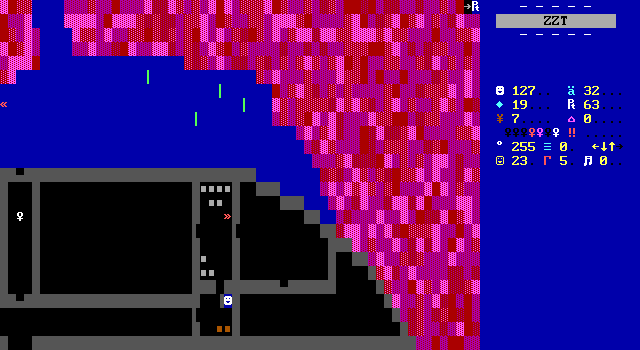

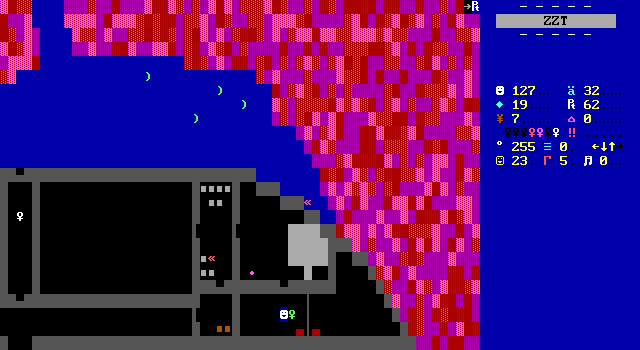
All rooms on board the ship need to be discovered, with walls and interior contents being purposely kept invisible until relevant doors are opened or the player is detected in specific positions. This goes well beyond what Nadir did in Lebensraum, where the contents of rooms was hidden, but their shape was always shown. This lets dave really surprise players as several boards consist of both the ship's interior and the outside ocean. You won't have the slightest hint at what you're going to be up against until you're properly on the ship, and even then, you still need to throw open a door to see what you've stumbled across this time. Empty closets, lucky keys, babbling former-toplanders, obtuse machinery, and lots of crates may potentially be behind each door.
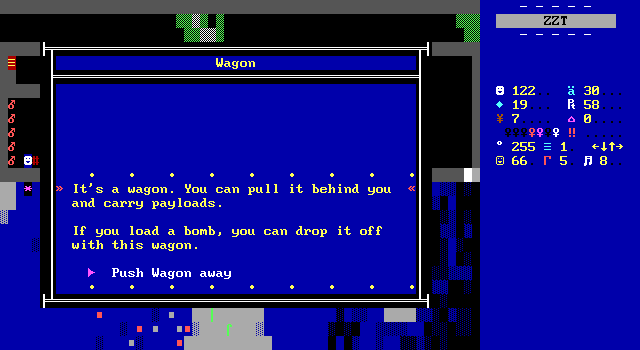
Of those, it's the machines that form the basis of the ship's puzzles that are the most interesting to find. A shared mechanic seen a few times is the use of a cart to move load with important items like bombs and power cells. These objects follow the player around without pushing, something that many games have done in the past. Where dave surprised me was with how nice they were to move around. The carts can be snagged on corners, and will try to find an alternate route, but if they can't, they simply act as if Peisinoë stopped pulling on them, waiting to be touched again before following some more. Touching them while carrying them will try and give them a short shove or slide them away from the edges of rooms. Dave does his best to prevent players from getting stuck, though things can get finicky and if you wind up pushing something into a place dave didn't expect you to, it can get dicey.
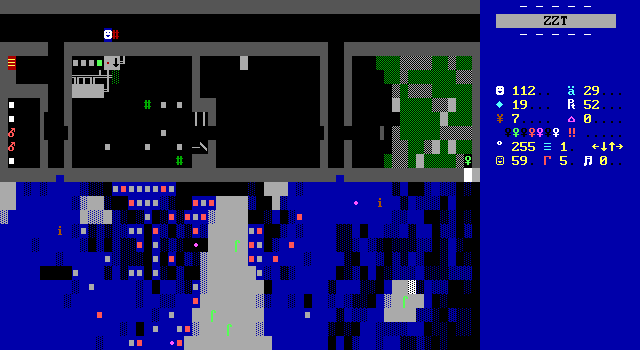
It's difficult to describe it in words, but these carts are the best escorting objects I've come across in ZZT. This is combined with some of ZZT's greatest doors, which can be pushed from either side, and even smacked with other carts that slide around, allowing them to open via force and not just the player's touch. The doors also look different from the de-facto standard of thin lines and slashes, operating instead with chunky half-blocks, shuffling between characters in a mechanical manner that really gives players the sense that these are heavy metallic ship doors and not your usual wooden rectangles with a knob. Seriously, I'm dedicating a portion of this article to making sure you're aware of how cool the game's doors are. Have you ever been excited about ZZT doors before? They're really good here. The doors...
For some more specific puzzles, Peisinoë is expected to cart bombs across boards to reach wreckage that can be blasted away. We're talking City of ZZT's Maximum Security, without the tedium of having to use boulders to move bombs safely. Admittedly, the margin for error here is basically zilch, so players should be cautious about how the bombs are placed.
The other cart puzzle relies on loading two carts with power cells and shoving them down a conveyor belt into another room to restore power to a critical part of the ship's systems. These carts run on ice physics, with the gentlest touch causing them to slide away from the player until they strike something. Peisinoë will need to slide them from room to room and find ways to reach the other side in order to get the cells into the proper position.
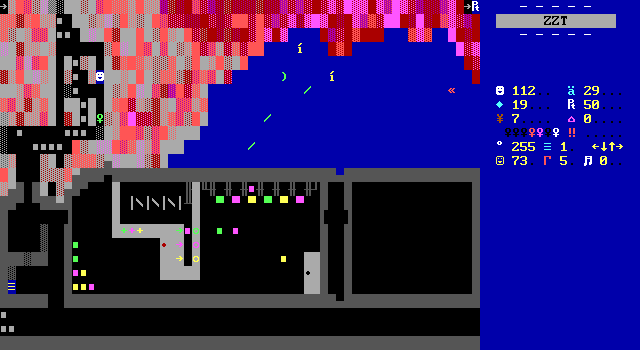
Another puzzle involves operating a machine to produce boulders of specific colors and then loading them into chambers. Mistakes here just cause more garbage blocks to fill the room, and while there's plenty of space to spare if you're not trying to maximize the number of needed colors produced simultaneously (the machine always outputs three) you might find yourself struggling. I enjoyed this one quite a bit as it wasn't a matter of just matching the first pattern displayed, but quite a few more, slowly introducing more color combinations to the mix. As a kindness to the player, the puzzle begins with an incorrectly colored boulder placed in one of the compartments forcing players to see what happens when they make a mistake as one has been pre-made for them. No consequences here. An incorrect color is simply erased, leaving the others intact as well so you don't have to start the entire sequence over.
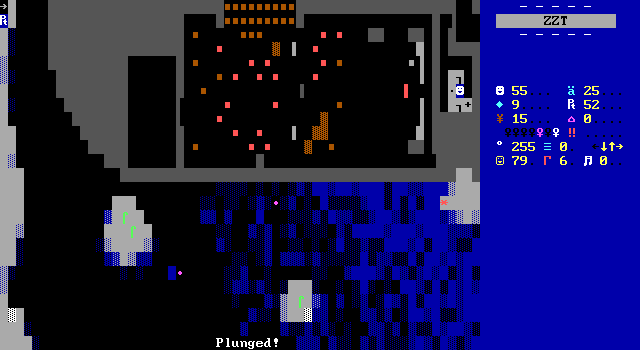
And then, just to be cheeky I'm sure, one room consists of a gigantic pinball table with flippers and bumpers for Peisinoë to operate. The goal being to clear out a bunch of boxes by smashing them to bits with the ball. It's more Breakout in that regard. No doubt, this is dave calling back to his earlier days with his first published ZZT world Pynball. It got a smile from me, although I was terrible at it. Again though, no penalty for dropping the ball other than wasting time.
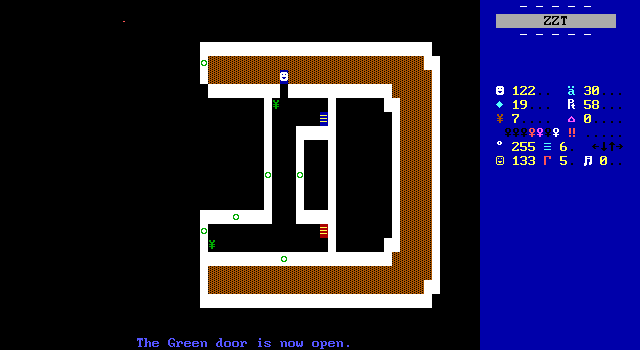
All these puzzles are done for seemingly no reason, powering systems and providing keys to open up areas on the ship's deck. A common occurrence throughout the game is that multiple keys of the same color will be provided. Dave turns this into a puzzle of sorts itself. On the deck players are presented with a multitude of doors without any idea of which need to actually be opened. The game provides enough keys to unlock everything, so players that discover a broom closet rather than the captain's office won't be stuck. Several doors also lead to the same room from different sides, so as the layout of the deck is revealed it becomes easier to use keys efficiently.
All of this goes back to dave2's idea that Oil is a game that has a speedrunning component to it. Expert players can undoubtedly route what puzzles and quests provide what keys, and only open the essential doors. For first time players, the fact it's fun doing things to acquire keys is more of a reward than unlocking a door, so if even when you reach a dead end there's no frustration felt. You may find yourself glancing over at your remaining time and getting a little nervous though.

Eventually, Peisinoë will find what she's looking for and be able to get the Endemus moving again. The game culminates in one last engine, the very same one used in the original 24HoZZT release of Oil! It's very fitting to see the game come full circle like this, now fully fleshed out and with the engine toned down a bit from the original's notoriously high difficulty.
Flotsam
Some stuff that I have to mention that couldn't be squeezed elsewhere:
The world that dave2 hints at here is cool! The merfolk have their own culture that players will learn over the course of the game. It doesn't take much to be sympathetic towards man causing ecological disaster, but the more alive the world comes off as, the more tragic the merfolks's plight feels.
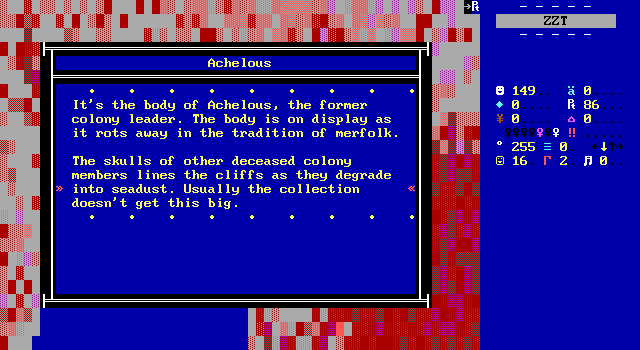
Early on players will come across the burial grounds finding some water eroded pillars with the body of the village's previous leader resting on top to be reclaimed by the sea. This is an insignificant thing as far as the gameplay goes, but it does so much to make the merfolk feel like more than soggy humans that get shoved underwater. These people have their own customs and way of life that the toplanders know nothing of, not even that they're about to destroy it.
More history is scattered throughout the adventure as well. Himerope will mention how she was intended to be next in line to lead the colony before cutting off the conversation. There's nothing to indicate what happened to change this, leaving it entirely up to the player's imagination. Himerope offers other clues into the merfolk's story. She's also the only one that really speaks out on the mysterious redscale, mentioning how toplanders had come one before in search of the material, doing anything to get their hands on it, and decimating the merfolk in the process.
It's unclear what exactly is going on with redscale, but it ties the fate of the Endemus and the merfolk together. I'm not sure if dave has anything more for this world, perhaps to be explored in a future release. What's seen in Oil hints at something more. Whether or not there's actually anything there is yet to be seen.
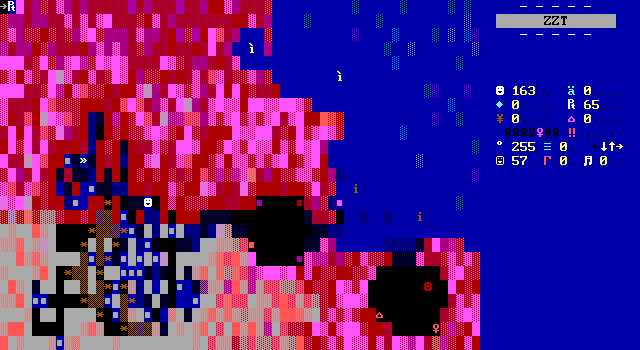
The cave next to Himerope's home is also one of the more impressive bits of coding in the game. Oil is seeping in from the cracks, and Peisinoë can try and find a way to stop the leak. Unlike the inky black trail of oil leading directly into their village, here dave2 uses slime whose trail is regularly erased. Players need to carefully navigate the cave, blocking off paths so that the slime elements themselves dissipate. Until they do so, the oil comes and goes, creating a nice visual effect that makes it so that the oil-slime can turn around once its trail is wiped out, allow it to spread repeatedly across the same area. Actually blocking it all off requires shrinking it down into a much smaller area, and if the player doesn't act fast, things can get out of hand, overtaking the cave, its current occupant, blocking off a treasure inside, and just making things more difficult. As a kindness to players, the oil here doesn't begin to actually spread until Peisinoë ventures into the cave, allowing them to check out the rest of the board without penalty for not knowing in advance that there's another form of time limit functioning here.
Oil does a solid job with its visual details. Many decorative objects don't only animate, but sway back and forth in the currents. The open nature of most boards means that even when moving they don't really get in the player's way. With movement and life going hand in hand, stillness implies death. Dead seaflowers can be found near oil sources indicating the danger and what's at stake here. The game is often minimalist, and so having things bob around even just a tiny bit do a lot to break up the stillness these scenes would otherwise impart.
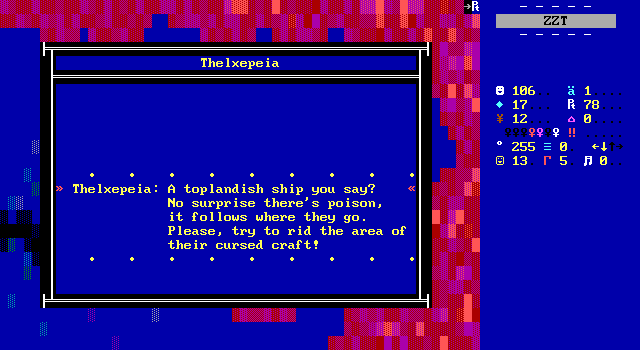
The cast of characters is solid. Peisinoë may be on her own, yet everyone has some way in which they can help, whether that be by providing resources or information. NPCs are more involved than merely spitting out canned dialog. As Peisinoë makes discoveries, others may comment on them, contributing to the idea that this is a game where time really is advancing even if ZZT can't really depict changes to the boards themselves. Most merfolk are strictly business, but even so they still are able to show off unique personalities.
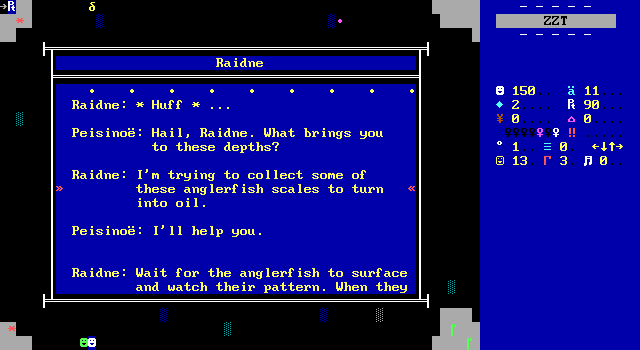
Dave2 is also adept at making his use of characters for tutorials feel natural. Learning how to harvest anglerfish scales feels like a friend showing you a cool thing rather than a wikiHow article providing step by step instructions for activities nobody asked about.
Oil even provides multiple ways to board the Endemus. When Cadmus gives a demonstration on how to use arrows, they point out how they can even be used to break some terrain. Players that keep an eye out may find an alternate entrance that can save a significant amount of time. Less impressive, but still worth noting is that the ship's doors can frequently be unblocked once inside, allowing anybody the chance to navigate to and from the ship much faster than normal. Having a quick escape from the ship to the village makes going back for health and ammo a much more appealing proposition.
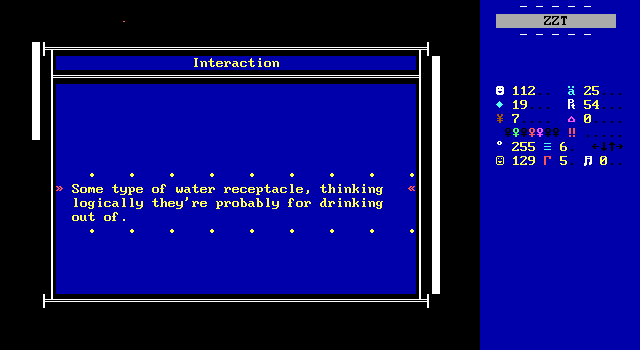
It also has my new favorite ZZT description of a toilet.
Final Thoughts
Oil is quite a lot of fun!
Its unique history definitely makes it a bit more interest to those in the know (congrats you made it this far and are now in the know), yet that history isn't necessary to enjoy the game. Dave2's return to ZZT after a considerable hiatus shows that he's still got it, making such a unique take on the typical action/adventure genre. The setting is executed well, with swimming around being a natural interpretation of how players move across ZZT boards.
The real winner here is just how well dave2's timer system works. Thanks to the numerous keys scattered all over, and the fact that there are more than needed to get through the game, players have no real idea how close they are to the end at any time. It deters players from taking the tedious action of waiting for a bunch of seaweed sandwiches, and the open boards populated with few enemies mean players can push themselves to explore just a little further even when their ammo gets low. Everything about the game encourages players to keep moving while constantly putting them in situations where they have to slow down and take a look at the clock while they wait. Even ZZT's one key per color limits matters as many times your reward for completing a room will be a key you already have, forcing you to come back again later to collect it.
Update: Jan. 31, 2023: Oil has received a bugfix update. The issues below should hopefully be resolved.
The one thing I didn't mention at all is that the game in its state at the time of writing is a bit buggy. I don't usually decide to cover a newly released game the day of its upload! These bugs are mostly small stuff, a few changed labels will cause things like books to spit out errors after reading rather than returning to the table of contents. I had a toplander zombie or two error out rather than dropping their keys (but there were still plenty to go around). Only two bugs actually had an effect. The first being that a flag wasn't updated after returning Asterope's pet fish Trito, resulting in the reward of some bonus time not being applied and another character thinking they were still in your company. (?-TRITO and ?+TRITO2 will let you fix this when it happens.) The other was a bit more grave, as one of the rooms on the Endemus has some sharks and some crates. The sharks can push things around and it's possible for the door to become unable to fully open if you don't run in and deal with them right away. I also had an issue with one of the carts getting pushed out of the room its meant to be in and spent far too long trying to engineer a way to get it back where it belonged.
By today's standards these issues are very noticeable. In the past these quirks would have been a bit easier to overlook. I'm still overlooking them for the purpose of this article as dave has expressed interest in providing an update to fix things that's has yet to be uploaded at the time of writing, but will be more likely available by the time this article is made public. Even without the fixes, needing to ?ZAP a door isn't actually that big of a deal, and saving before starting a puzzle is a cornerstone of smart ZZTing.
Overall though, Oil is a very promising return for dave2. The adventure is quick enough to play in a single sitting, and the emphasis on speed and high scores gives players opportunities to return again and again once they know the secrets of this world beneath the waves. Ultimately the timer was more generous than strict, but for those that find any kind of time limit on their play to be a turn off, the ability to disable it entirely ensures that the game can be enjoyed by all. This ended up being a great little game to end the year on, and is one I would highly recommend.
Unfortunately, the submission date for the Autumn 2003 was nineteen years ago, so I'm going to have to dock a significant number of points for the late entry. 0/10.
- [1] Was he eight years old? No.
- [2] Admittedly, I wouldn't have gone from the game being uploaded to selected it for a Closer Look were it not for the fact that the game I had chosen turned out to be very short and simple, with little to say and little enthusiasm to write for at the time. Perhaps it will have another chance later...
- [3] There is an upper limit here. While other healing sources don't restrict the player's maximum health, the source in the village caps players at 200. That's still a solid amount of health for this game.

